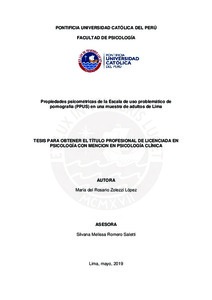| dc.contributor.advisor | Romero Saletti, Silvana Melissa | es_ES |
| dc.contributor.author | Zolezzi López, María del Rosario | es_ES |
| dc.date.accessioned | 2019-07-02T16:09:12Z | es_ES |
| dc.date.available | 2019-07-02T16:09:12Z | es_ES |
| dc.date.created | 2019 | es_ES |
| dc.date.issued | 2019-07-02 | es_ES |
| dc.identifier.uri | http://hdl.handle.net/20.500.12404/14500 | |
| dc.description.abstract | El consumo de pornografía es una costumbre tan antigua como controversial y
extendida, sobre todo entre la población masculina. El uso problemático de pornografía
(UPP), definido como un tipo de adicción conductual asociada a la evitación de
emociones negativas, no ha sido estudiado en nuestro medio. Por ello, el presente trabajo
se ocupa del análisis de las propiedades psicométricas de la Problematic Pornography
Use Scale –PPUS (Kor et al., 2014) en una muestra de 296 adultos de Lima (M=27.5,
DE=11.38), a fin de incorporar el constructo en la investigación y la práctica clínica. La
escala fue traducida por expertos y sometida a un análisis factorial con extracción de ejes
principales y rotación oblimin. Se obtuvieron 3 factores en vez de los 4 propuestos por
los autores. Pese a ello, la PPUS mostró evidencias adecuadas de confiablidad (α=.89) así
como de validez convergente, discriminante y de constructo, encontrándose correlaciones
significativas y fuertes con la BPS -Brief Pornography Screener- (r=.78); moderadas con
adicción a internet (r=.34), y entre pequeñas y moderadas con todas las dimensiones del
inventario de salud mental MHI-P. Asimismo, se encontraron las asociaciones esperadas
entre puntaje PPUS y sexo, edad y estatus de pareja, pero no con nivel de religiosidad.
Adicionalmente, se buscó evidenciar diferencias entre hombres y mujeres respecto a su
relación con la pornografía (n=358). Se realizaron comparaciones de medianas en las
variables frecuencia, influencia, expectativas, edad de inicio y actitud ante la pornografía,
encontrándose diferencias significativas en todas ellas, con efectos entre pequeños y
moderados. | es_ES |
| dc.description.abstract | Pornography consumption is a habit as ancient and controversial as it is common,
especially among men. Problematic Pornography Use (PPU), defined as a type of
behavioral addiction linked to the avoidance of dysphoric affect, has not been studied in
our context. Therefore, the purpose of this study is to analyze the psychometric properties
of the PPUS (Kor et al., 2014) in a sample of 296 adults from Lima (M=27.5, DE=11.38),
in order to have a valid measure of the construct. By using factorial analysis, Oblimin
rotation and principal axis extraction, we obtained 3 dimensions instead of the 4 factor
structure proposed by its authors. Nonetheless, the psychometric properties of the scale
as well as its internal consistency (α=.89) were adequate. Convergent validity was
assessed with the BPS -Brief Pornography Screener- (r=.78); discriminant validity with
an Internet Addiction Scale (r=.34) and all scales and subscales of the Mental Health
Inventory MHI-P. Construct validity was assessed with sociodemographic indicators of
Frequency and Amount of Consumption. We also confirmed the hypothesized
associations between PPUS score and gender, age and relationship status, although not
with religiosity. After that, we aimed to test gender differences regarding several aspects
of their relation with pornography, such as expectations, influence, attitude and age of
first access. Medians by gender of the whole sample (n=358) were compared and
significant differences were found in all variables, with effect sizes ranging from small to
moderate. | es_ES |
| dc.language.iso | spa | es_ES |
| dc.publisher | Pontificia Universidad Católica del Perú | es_ES |
| dc.rights | Atribución-CompartirIgual 2.5 Perú | * |
| dc.rights | info:eu-repo/semantics/openAccess | es_ES |
| dc.rights.uri | http://creativecommons.org/licenses/by-sa/2.5/pe/ | * |
| dc.subject | Conducta sexual--Aspectos psicológicos | es_ES |
| dc.subject | Pornografía en Internet | es_ES |
| dc.subject | Pruebas psicológicas | es_ES |
| dc.subject | Psicometría (Psicología) | es_ES |
| dc.title | Propiedades psicométricas de la escala de uso problemático de pornografía (PPUS) en una muestra de adultos de Lima | es_ES |
| dc.type | info:eu-repo/semantics/bachelorThesis | es_ES |
| thesis.degree.name | Licenciado en Psicología con mención en Psicología Clínica | es_ES |
| thesis.degree.level | Título Profesional | es_ES |
| thesis.degree.grantor | Pontificia Universidad Católica del Perú. Facultad de Psicología | es_ES |
| thesis.degree.discipline | Psicología con mención en Psicología Clínica | es_ES |
| renati.discipline | 313026 | es_ES |
| renati.level | https://purl.org/pe-repo/renati/level#tituloProfesional | es_ES |
| renati.type | http://purl.org/pe-repo/renati/type#tesis | es_ES |
| dc.publisher.country | PE | es_ES |
| dc.subject.ocde | https://purl.org/pe-repo/ocde/ford#5.01.00 | es_ES |






